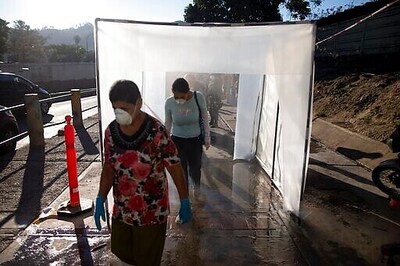
views
Finance Minister Nirmala Sitharaman’s maiden Budget is an exercise in populism, the promises of galvanizing the economy notwithstanding. There are only two good things about it: first, it somehow remains committed to fiscal prudence; and second, it persists with infrastructure development.
Indeed, it aims to bring down the deficit from 3.4 per cent to 3.3 per cent of the gross domestic product (GDP). The Budget also intends to boost infrastructure development. The means adopted to shore up revenue, like the Rs 2 per litre cess on petrol and diesel, are not very good but the deficit target may be achieved nonetheless. As it is, petroleum products, which are outside the GST net, are highly taxed; now the tax incidence will further increase. The government has also trashed concerns about higher inflation on account of the cascading effects of costlier diesel.
Then there is a hike in the surcharge on high net-worth individuals (HNIs)—that is, those having taxable income from Rs 2 crore to Rs 5 crore and Rs 5 crore and above. The move is not something that would endear the government to the rich; it is also likely to dampen the enthusiasm of the investing community towards India, but that the Narendra Modi government is more concerned about the feelings of the poor rather than the rich.
Typically, the Budget talks a lot about the poor. Sitharaman came up with a new slogan—gaon, garib, aur kisan (village, poor, and farmer). Her speech was high on rhetoric and slogans: the government aspires to make India a $5-trillion dollar economy; building Team India with Jan Bhagidari; Minimum Government, Maximum Governance; achieving green Mother Earth and Blue Skies through a pollution-free India; making Digital India reach every sector; people’s hearts filled with Aasha (Hope), Vishwas (Trust), Aakansha (Aspirations); Annadata (farmer) can also be Urjadata.
In practical terms, however, there was little that could bring real change in the countryside. Structural reforms in the farm sector — like freeing the farmer from the clutches of socialist rules — have not even been discussed. What he gets instead is same old mechanisms and clichés: livelihood business incubators, technology business incubators; 75,000 entrepreneurs to be skilled in agro-rural industry sectors; 10,000 new farmer producer organizations to be formed; letting farmers benefit from e-NAM; zero budget farming. The kind of stuff that keeps agricultural experts busy writing academic papers but brings little succor to peasants.
It is not that reforms have been introduced in other sectors; here too the same old rhetoric persists. Consider the case of micro, small and medium enterprises (MSMEs), for which all governments claim to be extremely concerned and which continue to languish.
It is the same old story of populism and palliatives: a Pradhan Mantri Karam Yogi Maandhan Scheme; pension benefits to about three crore retail traders and small shopkeepers with annual turnover less than Rs 1.5 crore; Rs 350 crore allocated for 2019-20 for 2 per cent interest subvention (on fresh or incremental loans) to all GST-registered MSMEs; payment platform for MSMEs to be created to enable filing of bills and payment thereof, to eliminate delays in government payments.
One of the few things business could be happy about is the reduction in the tax rate to 25 per cent for companies with annual turnover up to Rs 400 crore. Smaller enterprises may benefit from the interchangeability of permanent account number (PAN) and Aadhaar: those who don’t have PAN can file tax returns using Aadhaar. Aadhaar can hitherto be used wherever PAN is required.
The Budget also seems to be protectionist. The basic customs duty has increased on cashew kernels, PVC, tiles, auto parts, marble slabs, optical fibre cable, CCTV camera, etc. Exemptions from customs duty on certain electronic items now manufactured in India have been withdrawn.
Bank privatization is not on the agenda, Finance Secretary Subhash Chandra Garg made it clear at the press conference after the tabling of the Budget in Parliament. In fact, the government has committed Rs 70,000 crore to public sector banks, apparently for recapitalization.
Disinvestment in public sector undertakings, however, is very much there, with the government pegging the target for the current fiscal at Rs 105,000 crore.
The government looks committed to invest heavily into infrastructure. Sitharaman pointed out in her Budget speech that Railway infrastructure alone would need an investment of Rs 50 lakh crore between 2018 and 2030. The measures she is focusing on are essentially related to borrowing. Credit Guarantee Enhancement Corporation will be set up in 2019-2020. An action plan will be put in place to deepen the market for long-term bonds with focus on infrastructure. It is proposed to permit investments made by FIIs/FPIs in debt securities to be transferred/sold to any domestic investor within the specified lock-in period.
In a nutshell, the Budget doesn’t have anything that can be called a meaningful, let alone, big-bang reform. But then, there is nothing in it that can cause big damage. Perhaps we should count our blessings and not grumble about the missed opportunities.
(The author is a freelance journalist. Views Expressed are personal.)




















Comments
0 comment